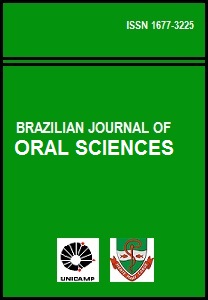Abstract
Oral health problems have more and more been recognized as important causers of negative impact to workers in the daily activities and quality of life. Aim: To identify the profile and selfperceived oral health among workers from a furniture industry. Methods: Data were obtained from a cross-sectional study in which the Oral Health Impact Profile questionnaire (OHIP 14 – short form) was applied to the workers focusing on their demographic profile and self-perceived oral health Results: 111 workers out of a total of 170 agreed to participate in the study; 84.68% (n=94) were men and the majority was under 35 years of age (68.81%, n=75). The following results were obtained for the different parameters evaluated: level of education, occupation, mean frequency of toothbrushing (number of times per day) (3.19), general health, dry mouth (7.2%, n=8), smoking (15.32 %, n=17), gingival bleeding (51.35%, n=57) and use of medications for toothache relief (38.74%, n=43). The mean OHIP value found was 0.51. Significant association was found between the mean OHIP value and general health and gingival bleeding. No significant association was found between the use of medications for toothache relief and gingival bleeding (p=0.729) or dry mouth (p=0.704). Significant association was found between use of medications for toothache relief and smoking (p=0.007). Conclusions: Knowing the habits and the profile of workers is a relevant factor to promote an oral health attention in the context of the occupational health; gingival bleeding was a strong indicator in self-perceived oral health and workers’ quality of life.The Brazilian Journal of Oral Sciences uses the Creative Commons license (CC), thus preserving the integrity of the articles in an open access environment.
Downloads
Download data is not yet available.

